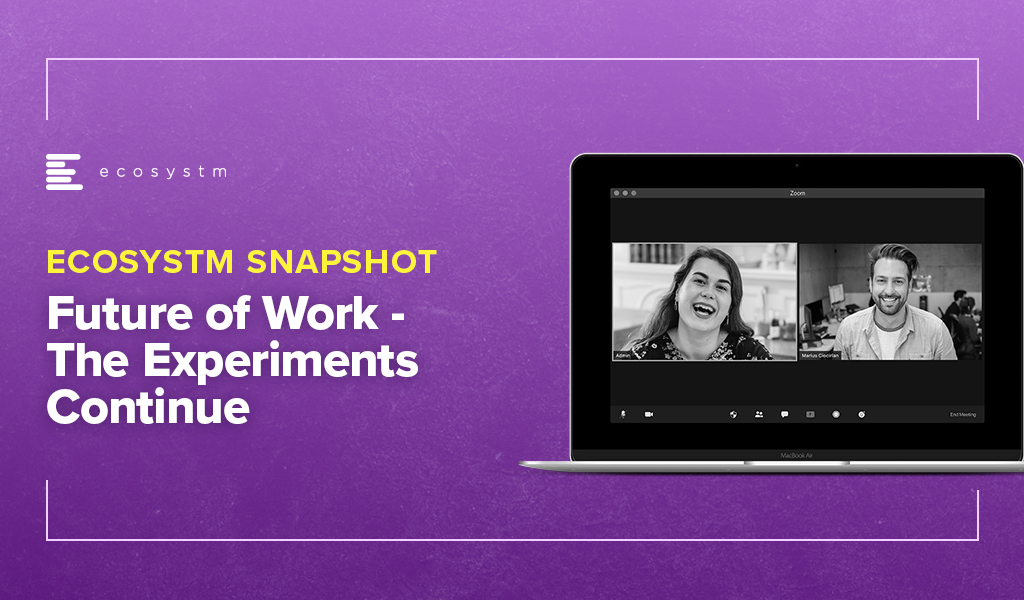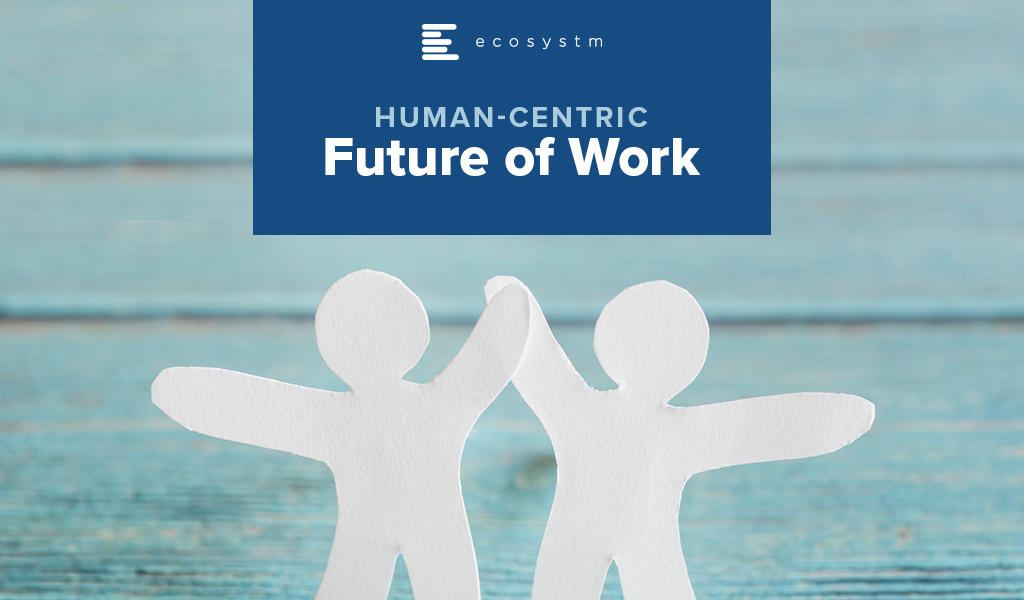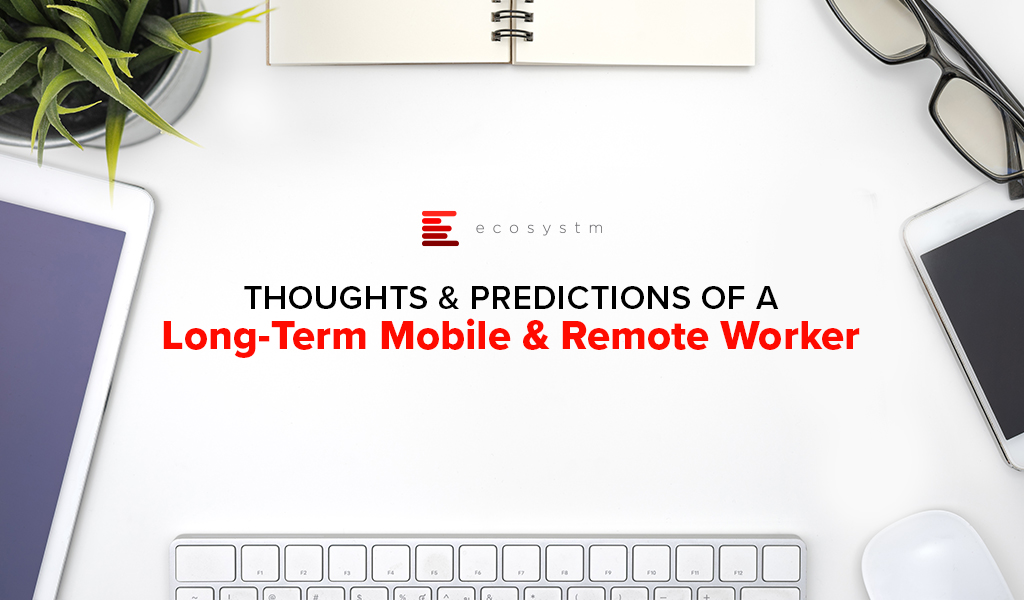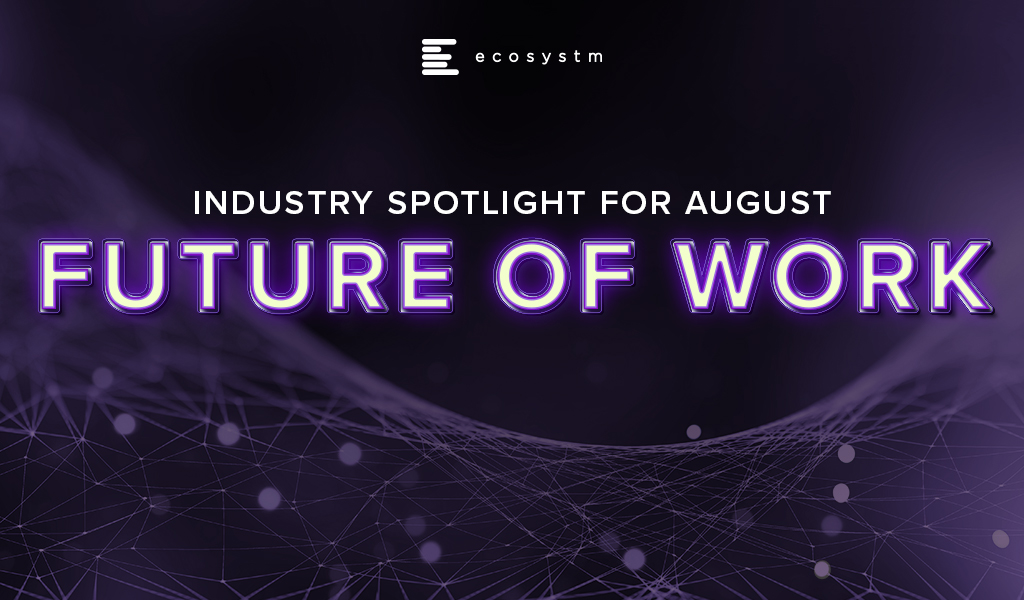Organisations across the world are experimenting with what work model would work best for them in 2021. The last week saw several announcements that make it clear that irrespective of the model that becomes prevalent, remote working and the hybrid/blended work model are here to stay.
Remote Working Remains a Reality in 2021
The reduced demand for office space has led companies to re-think their lease renewals and physical space requirements. Deloitte has announced that it will close 4 of its 50 offices in the UK. The four offices in Gatwick, Liverpool, Nottingham and Southampton employ around 500 people who would be allowed to move to other locations or offered permanent remote working options. Ecosystm research finds that about a quarter of global organisations expect to reduce commercial office space in 2021.
Most organisations have introduced remote working options till the end of 2020 and beyond; while some others have made working from home a permanent option. Organisations will have to re-evaluate when employees can be realistically expected to come back into the office, and many will extend their work from home policy. Amazon recently announced the extension of its work from home policy till June 2021, from January 2021. Other organisations are expected to follow suit as the virus continues to be active in many countries.
The Experimentation will Continue
Companies will continue to enable seamless collaboration that spans across virtual and physical realms. But what will be important is to see how organisations can successfully incorporate a remote working culture across its different locations. Dropbox has announced a new ‘Virtual First’ remote working policy which includes features such as the ability for employees to decline unnecessary meetings, and a way to open source their learnings with the wider business community. Dropbox will still retain some physical spaces called Dropbox Studios, that will either be repurposed office space or entirely new spaces designed for meetings, group events and special offsites. The core collaboration hours will typically be between 9am-1pm, as employees are no longer expected to be in the same locations or time zones.
Ecosystm Principal Advisor Ravi Bhogaraju says, “Flexibility (Work from home or Office Anywhere) is a company strategy and not a tactic. It needs to be evaluated within the context of the overall strategy of the company, how it creates value and how technology and talent can help provide better customer experience.”
Another experiment that was announced last week was Dubai’s efforts to revive its tourism industry. Remote working has been associated with stress and organisations are increasingly having to monitor employee emotional well-being. To overcome this, Dubai is inviting overseas remote workers to expand their workplace and remote working environment. Dubai’s new remote working program is welcoming remote workers with a valid passport, health insurance, proof of employment and a minimum monthly salary of USD 5,000 to visit and work from Dubai. Programs such as these highlights the potential change in the work environment that we might witness.
Talking about the implications of such moves on organisations, Bhogaraju says, “having everybody as free agents within the network working from anywhere – without fully enabling the process and workflows across teams and the entire organisation – will require a lot more patching or coordination. It can impact the customer experience, and also opens up the firms to compliance, tax and regulatory risks if not carefully managed – especially when cross-border work is involved.”
With experiments such as these, it will become even more important for organisations to ensure that they have the right technology in place that can not only ensure seamless access to company resources irrespective of the location of the employees but also that IT and cybersecurity teams are not overburdened by the need to secure the endpoints and network.
Other Factors to Consider
While organisations must keep working on understanding the right model that will work for them, there are some other factors that they should consider.
Ecosystm Principal Advisor, Mike Zamora says, “what employees are learning is that their home expenses are increasing – E.g. electricity, connectivity costs, and even food where employers have previously provided snacks, beverages and lunches. Increasingly this needs to be addressed by Businesses in order to maintain a strong connection with employees. If not, when the economy recovers, companies might find their talent moving to other companies.”
“As some companies have limited return to the office, the Business and Employees have learned what is essential to be completed at the office. This is usually collaborative tasks which cannot effectively be done through remote collaboration. In addition, there are some specialised assets (special work rooms for some industries) which cannot cheaply or effectively be recreated in the home environment.”
Bhogaraju also cautions, “an advantage of working from anywhere is that it opens up talent pools that were not available or accessible to employers before. However, without knowing what kind of employees would be needed to sustain the strategy on a mid to long-term basis the hiring would probably result in poor fit to the working environment – and lead to a spike in attrition as the employees would not be able to cope with the working arrangement.”
Download Ecosystm Predicts: The top 5 Future of Work Trends For 2021
The full findings and implications of The top 5 Future of Work Trends For 2021 are available for download from the Ecosystm platform. Signup for Free to download the report .

The 360o Future of Work practice takes into account the changing business environment, and what companies need to become an “Empowered Business”. It consists of four components: The Business, The People, The Technology, and The Work Environment.
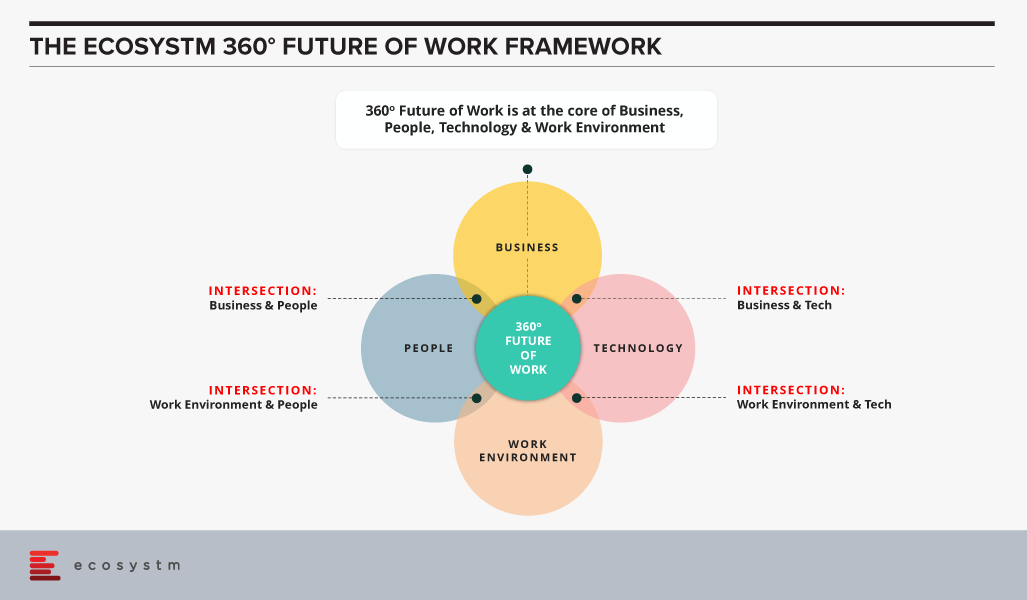
Here we focus on the Work Environment, and its intersection with the three other components.
Work Environment: A Component of the 360o Future of Work
Companies and people have learned work can be performed in many types of environments, just as business is conducted in varying venues. Each space will have a different impact and outcome. The three primary commercial areas are: office, industrial and retail. While industrial and retail commercial areas will be addressed later, we talk here primarily of the office environment. The office environment is designed to enable both collaborative and individual work. It has historically been densely packed. Post COVID-19, this environment will probably be modified. For the past few years, an alternative to the office environment has been co-working – a shared work environment with other companies, in open plan arrangements. It provides a way for business to save capital by minimising the expense of fit out. The combination of using both office and co-working environment is what will begin to be called “the Blended Environment”.
The Work Environment and its Intersections
While the Work Environment is an important component of the Future of Work, it is a co-enabler with Technology to support the People and Business.
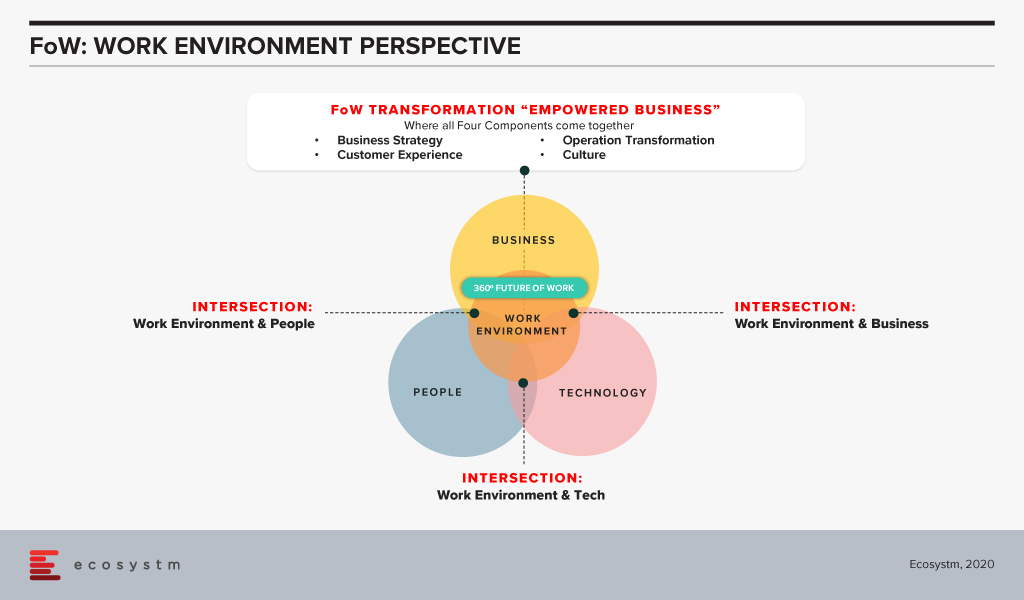
Work Environment – Intersection with the Business
The Business’s role is to provide Strategy and Direction. If done effectively it can take on unknown challenges. Examples of how the Business intersects with the Work Environment would be:
- Providing agility to the Business in preparing for any future crises. Some examples of how this can be done is by looking at how the space is controlled by the lease conditions, and how it is used by the occupants and the type.
- Aiding to minimise risk from excess space. An example would be space options for a lease. This will enable both spatial and financial flexibility for the company to expand or contract as needed.
Work Environment – Intersection with People
A critical component of the Empowered Business is its People – its workforce. For any company, the People are the key asset. They have to be able to grow and develop, in order to provide collaboration and idea creation. Examples of how the Work Environment can empower the People would be:
- The focus is on aligning the space with the employee’s task.
- The focus is on aligning where a person needs space to be effective, and the task the person needs to perform.
Work Environment – Intersection with Digital (Technology)
One of the important enablers of any Business, especially the Empowered Business, is its Digital Tools. They support the Business and its People, along with the Work Environment. They allow the Work Environment to be productive and effective. Examples of how Technology and the Work Environment intersect would be:
- This is where the two enablers (Digital Tools and Work Environment) work together to aid the employees and the business.
- This relates to how to manage the Business’s portfolio of space from a remote location.
These four components working together will enable an Empowered Business. The Work Environment as an enabler allows the Business to pivot, adapt, and thrive in the most challenging environment. It allows the Empowered Business to be better prepared to meet future crises head-on.
Schedule a time to speak with us on Future of Work
Ecosystm Principal Advisors; Tim Sheedy & Audrey William (Technology), Ravi Bhogaraju (People & Organisations), and Mike Zamora (Work Environment) provide a holistic view of what the Future of Work will look like.
We enable businesses to adapt, pivot and thrive in their ecosystem; provide holistic access to data and insight across People, Technology and Work Environment; help businesses transform and be better prepared for future disruption, and the ever-changing competitive environment and customer, employee or partner demands.
Contact us through the platform, or over email at info@ecosystm360.com

The Future of Work is here, now. Organisations faced unprecedented challenges of coping with the work-from-home model, when COVID-19 hit earlier this year. Many organisations managed the pivot successfully – but all organisations were impacted in some way.
The COVID-19 crisis has required major resets in how organisations function – across industries and economies. In this environment of intense changes, businesses that have been agile in their operations and their mindsets and were better digitally enabled have thrived, while others have struggled.
Our 360o Future of Work practice focuses on Business, People, Technology and Work Environment. All four are required to work together to enable companies to meet future challenges. The Future of Work enables companies to Pivot, Adapt and Thrive.
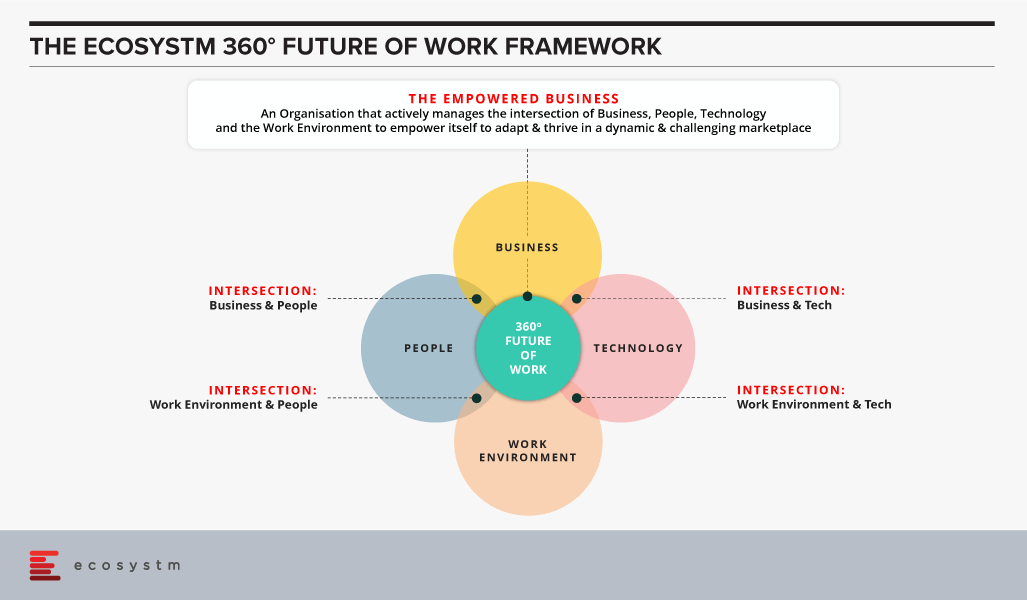
The People practice within the Future of Work helps organisations adapt their People strategies in conjunction with the other areas to drive a holistic approach in the Future of Work strategies.
The Need for Human-centricity
Talent has always been a key company asset that brings product and service offerings to life. HR teams have retained a constant focus on attracting and retaining talent. HR teams have come into sharp focus as the pandemic rages across the world. With the closure of offices and borders, and distancing measures, companies have had to focus their energy on their people and the work infrastructure – almost overnight.
With every passing week, the situation keeps evolving – and so do the ways of managing and engaging with employees and customers. As countries and businesses slowly reopen and modify their distancing protocols the People strategies will have to evolve rapidly.
Every organisation is now grappling with the decision of whether to “reopen” and go back to how things were; or think of alternatives and opportunities that they can capitalise on to strengthen their businesses.
The 4Es of People: Experience Journeys
The cornerstone of the People practice within the Future of Work is to align the Customer Experience and the Employee Journey.
It is not just about finetuning the employee process or employee life cycle in isolation. That is a consequence of the tweaks to the overall journey.
Depending on the phase of the company that you are in (Pivot, Adapt and Thrive) the changes to the employee experience would vary. The 4Es of People is designed to help you make that happen.
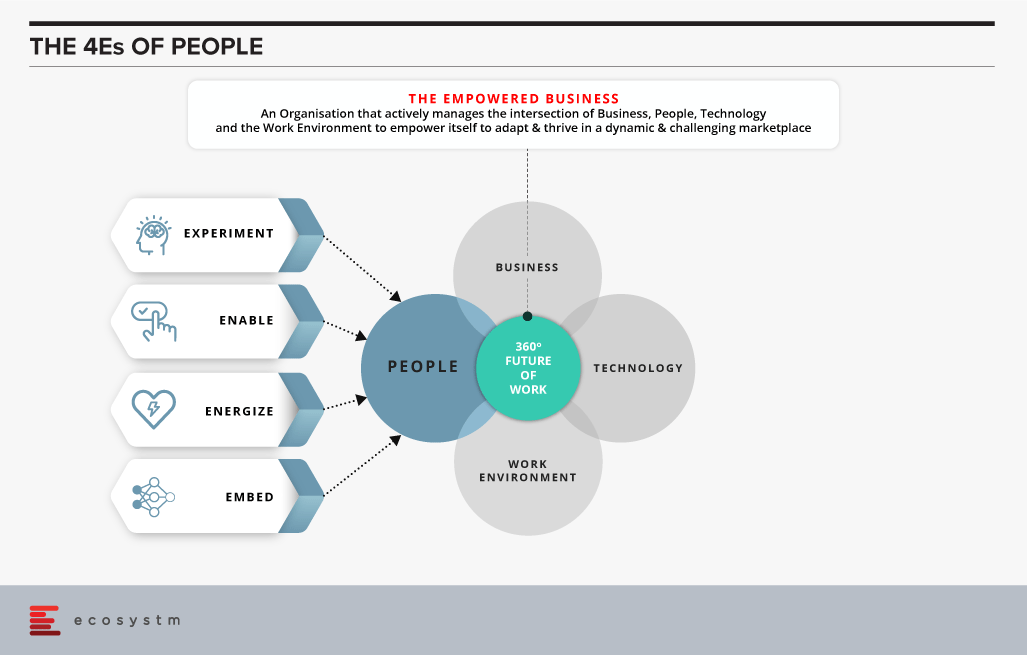
Experiment. HR leaders are increasingly being asked to “orchestrate” companywide experiments to help figure out the way forward. An Experimentation Mindset is crucial to finding the right solutions fast. This needs to be done in a small and holistic way – some examples include thinking of different workforce models, working contracts and benefits, working archetypes, technology and data enablers and workplace models.
Enable. Two main areas of enablement that need to be looked at are: the human elements of talent, capability, leadership and culture to align to the business strategy pivots; and the associated elements of technology, workspace and analytics.
Energize. Key HR competencies of empathy and collaboration are increasingly becoming crucial to ensure that the organisation is staying well, motivated and focused through these demanding times.
Embed. The ability to learn from the experiments, finetune the overall system within and outside the company, and support the changes over the longer term are crucial to help companies scale the models and gain sustained competitive advantage over the mid-term.
The 4Es of People can be effective in adding the right elements and outcomes to support the changes. These are intended to enable HR to help organisation establish their Future of Work strategies and implement them effectively. This will help them to be prepared for whatever model of work becomes prevalent in the future.
Schedule a time to speak with us on Future of Work
Ecosystm Principal Advisors; Tim Sheedy (Technology), Ravi Bhogaraju (People & Organisations), and Mike Zamora (Work Environment) provide a holistic view of what the Future of Work will look like.
We enable businesses to adapt, pivot and thrive in their ecosystem; provide holistic access to data and insight across People, Technology and Work Environment; help businesses transform and be better prepared for future disruption, and the ever-changing competitive environment and customer, employee or partner demands.
Contact us through the platform, or over email at info@ecosystm360.com

COVID has delivered to many companies around the world a knock-out punch which has put them on the mat. They aren’t knocked out; just dazed, as any experienced fighter would be when caught off guard with a hard blow.
One way companies have dealt with the hard blow is in their Work Environment. At the beginning of the pandemic, many businesses simply sent office workers home. Some had corporate guidance and IT support; others simply were told to “make it work”. Post COVID, there will be a New Natural State of Equilibrium in the Work Environment and the business world. In this blog, I will talk more about the Work Environment.
First let me explain my interest in the subject. I have been a full-time mobile and part-time remote worker for over 13 years with a global technology company. I have designed many mobile office environments throughout Asia, working with business units to understand their needs and to educate them on the changes required and the change management process. For over 10 years I have taught this subject around the world to fellow professionals – across industries – in Asia, Australia/New Zealand, Europe and the USA. I was based in Hong Kong during the 2003 SARS outbreak. These experiences have given me a keen understanding and perspective on what happened in the early days of COVID-19, and insights on what the future could look like for many businesses.
Let’s look at some basic Work Environment facts:
- It costs a company an average of over US$10,000/year per employee for their physical space.
- Remote working happened very quickly at the start of COVID-19, almost overnight for some companies and employees.
- There are many venues available to conduct work from, over the long term: Office, Home, the 3rd Space (coffee shops, etc) and other venues.
I recently read the Harvard Business School (HBS) working paper titled, What Jobs are Being Done at Home During the COVID-19 Crisis? Evidence from Firm Level Surveys. Key findings from the report include:
- While overall levels of remote work are high, there is considerable variation across industries.
- Remote work is much more common in industries with better educated and better paid workers.
- Employers think that there has been less productivity loss from remote working in better educated and higher paid industries.
- More than one-third of firms that had employees switch to remote work believe that it will remain more common at their company even after the COVID crisis ends.
The Emergence of the Future of Work
Mobile & Remote Work. The cost of housing a worker in an office environment has always been a concern for senior management. The cost quickly adds up, even for a small or medium-sized firm. The physical cost of the office is typically the second largest expense for a company, after employees’ salaries. This is one reason that “densification” has occurred in the office environment over the past 10 years or so. It is also a reason remote working (working outside the office – from home, coffee shop, hotel, airport lounge, etc.) has been attractive to companies. If the office environment is designed with multiple work-type spaces (e.g. collaborative, non-collaborative, quiet, etc.), a permanently designated workspace is not required for a worker. This type of Work Environment is known as a mobile environment. Both of these Work Environments – remote and mobile – have been the trend for many companies (especially technology and financial firms).
Co-working. Beginning a few years ago, another Work Environment emerged: Co-working. One of the early market leaders was WeWork. Co-working is very similar to the mobile environment. It has the added benefit of not requiring any capital cost for the fit-out (tenant improvements). The company or individual rents a desk or space in a co-working environment and just pays the monthly fee. There is no delay to find the space, sign the lease, design, or construct the space, and no capital required for the construction cost. It is a “plug and play” space.
Blended Model. Given the selection, worker typology, and flexibility of space, all these alternatives will be used in some capacity in the Future of Work (FoW). The Work Environment will be a blend of these environments. Some have predicted the death of the office building. Ecosystm research finds that only 16% of organisations are looking to reduce their commercial office space, going into 2021. People are social creatures and need interaction with others, either for effective work collaboration or just to socialise.
The Future of the Work Environment
Figure 1 shows a compilation of the various type of Work Environments which office workers use and how they came about.
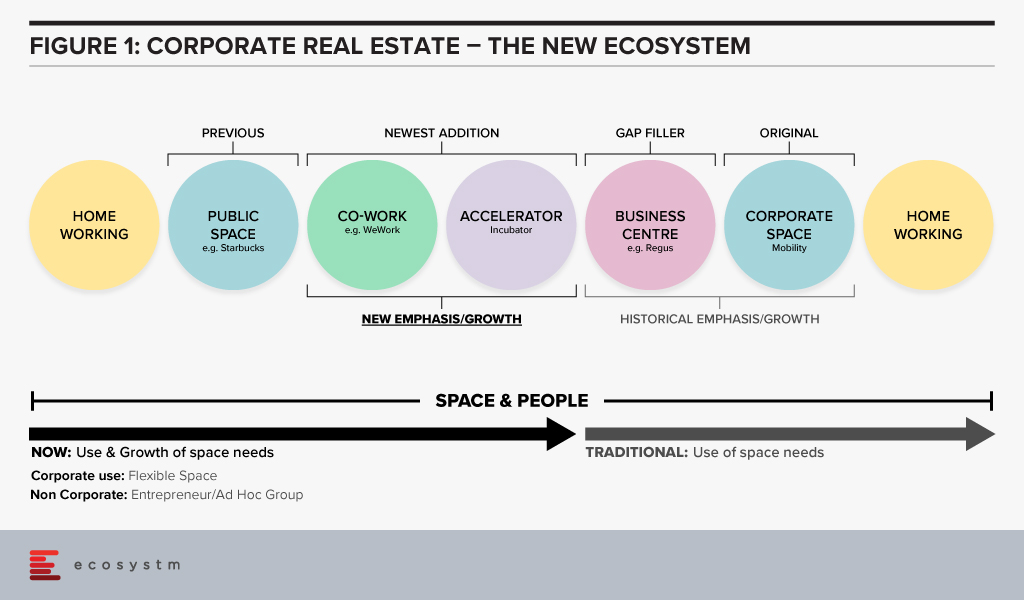
Each company, especially post-COVID, will have to look at their business strategy and determine how they will best solution their Work Environment to get the maximum benefits. These are the main questions each company has to ask and answer at a strategic level:
- What is the best workspace solution for my company and employees?
- Do employees want the corporate leased space? Does it help make them more productive?
- How is the marketplace (landlords) responding to this demand if a company is leasing space?
Role-dependent Remote Workers. Returning to the larger topic of the Work Environment, the HBS paper states there are different rates of remoteness across industries. I would assert that in addition there are different rates of remoteness among the types of workers. A salesperson needs to interact differently with fellow company employees compared to an accountant or an administrative person. Workers in the Banking industry interact differently compared to workers in the Technology industry. The article also points out that a better educated and better paid worker – or a knowledge worker – can more easily be a remote worker. For those of us who have been working in the mobile/remote Work Environment for many years, we know and understand this. Knowledge workers are not employed for their physical skills. For example, an assembly line worker in an auto factory cannot be remote.
Determining Work Typology. The paper also states that remote working will be more common in the companies that have not experienced a dramatic decrease in productivity from remote working. This has been asserted and demonstrated by us, the professionals in the corporate Real Estate industry. The industry has been experiencing increased productivity for many years. We have also conducted in-house studies of the various business groups that have experienced remote working. We have even gone so far as to provide work typologies for the various types of workers. Each typology uses the office Work Environment differently and has varying levels of remote abilities.
Need for Change Management. A critical component of remote work effectiveness is the mindset shift by both the employee and the manager. The managers have to modify their style to more of a “management by performance”, versus just walking around and checking whether people are busy. Similarly, employees have to understand they are being trusted to work unsupervised but will have to accomplish the required work and be held responsible. The manager and employee relationship will require new performance measures to hold people accountable and determine whether they are being effective and productive in their remote environment. All of this requires a change management program to educate both without compromising the corporate culture.
When the pendulum finally comes to rest in the near future at what will be the New Normal, the Work Environment will be modified. But, more importantly, the mindset of employees and managers will have to be adjusted. This new mindset will be required so each company can be more agile to meet the new challenges that will be awaiting every company and industry throughout the world. This will enable a company to not only survive but thrive in the next wave of quantum shifts. And yes, there will be another wave of quantum shifts in the future, lest we forget the examples of the past (eg. the 2007 Global Financial Crisis, 2003 SARS, etc.).
This article has focused on the Work Environment. The Work Environment is one of the four components of the 360o Future of Work practice at Ecosystm. The other three components are: People, Technology, and Business. All four are required to be in balance to enable companies to meet future challenges, competitors, and unknown black swans.

The Future of Work is here, now. Organisations were faced with unprecedented challenges of coping with the work-from-home model, when COVID-19 hit earlier this year. Many organisations managed the pivot very successfully, but all organisations were impacted in some way. Various trends have emerged over the last few months, that are likely to persist long after the immediate COVID-19 measures are removed by countries. In the Ecosystm Digital Priorities in the New Normal study, we find that organisations will continue to cater for remote employees (Figure 1) and keep a firm eye on employee experience (EX).
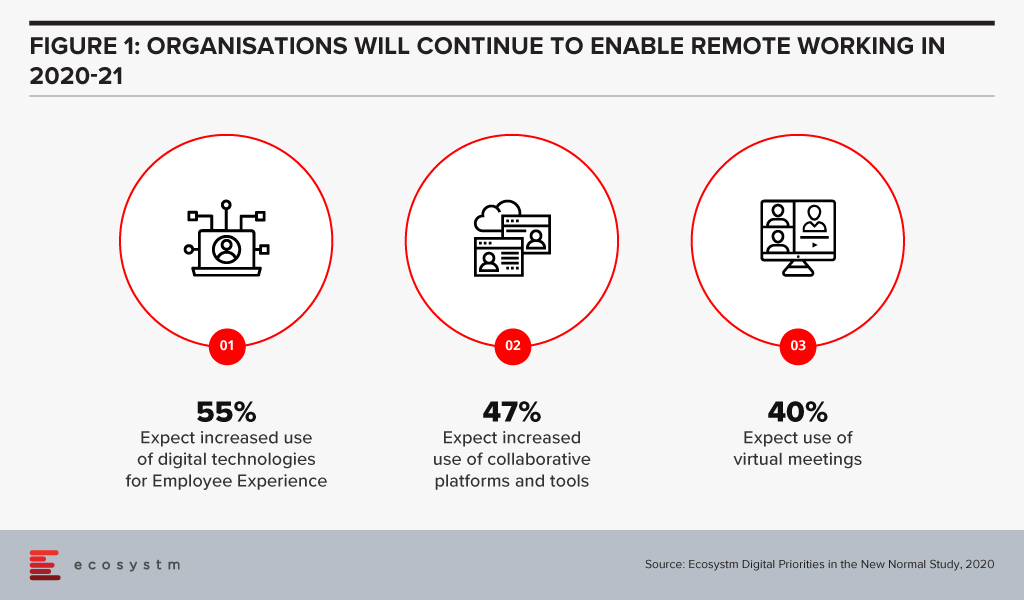
August has seen these clear trends in the Future of Work
#1 Tech companies leading from the front in embracing the Future of Work
As the pandemic continued to spread across the globe, various companies adopted the work from home model at a scale never seen before. While it is still unclear how the work model will look like, many companies continue to extend their remote working policies for the remaining year, and some are even thinking of making it a permanent move.
Tech companies appear to be the most proactive in extending remote working. Google, Microsoft, and AWS have all extended their work from home model till the end of the year or till the middle of next year. Earlier in the month Facebook extended its work from home program until mid-2021 and are also giving employees USD 1,000 to equip their home offices. This appears to be a long-term policy, with the company announcing in May that in the next 5-10 years, they expect 50% of their employees to be remote. Similarly, Salesforce and Uber also announced that they would be extending remote working till the mid-next year, and are providing funding for employees to set up the right work environment.
In Australia, Atlassian has made work from home a permanent option for their employees. They will continue to operate their physical offices but have given employees the option to choose where they want to work from.
Some organisations have gone beyond announcing these measures. Slack has talked about how they are evolving their corporate culture. For example, they have evolved their hiring policies and most new roles are open to remote candidates. Going forward, they are evaluating a more asynchronous work environment where employees can work the hours that make sense for them. In their communique, they are open about the fluid nature of the work environment and the challenges that employees and organisations might face as their shift their work models.
Organisations will have to evaluate multiple factors before coming up with the right model that suits their corporate culture and nature of work, but it appears that tech companies are showing the industry how it can be done.
#2 Tech companies evolve their capabilities to enable the Future of Work
Right from the start of the crisis, we have seen organisations make technology-led pivots. Technology providers are responding – and fast – to the changing environment and are evolving their capabilities to help their customers embrace the digital Future of Work.
Many of these responses have included strengthening their ecosystems and collaborating with other technology providers. Wipro and Intel announced a collaboration between Wipro’s LIVE Workspace digital workspace solution and the Intel vPro platform to enable remote IT support and solution. The solution provides enhanced protection and security against firmware-level attacks. Slack and Atlassian strengthened their alliance with app integrations and an account ‘passport’ in a joint go-to-market move, to reduce the time spent logging into separate services and products. This will enable both vendors to focus on their strengths in remote working tools and provide seamless services to their customers.
Tech companies have also announced product enhancements and new capabilities. CBTS has evolved their cloud-based unified communications, collaboration and networking solutions, with an AI-powered Secure Remote Collaboration solution, powered by Cisco Webex. With seamless integration of Cisco Webex software, Cisco Security software, and endpoints that combine high-definition cameras, microphones, and speakers, with automatic noise reduction, the solution now offers features such real-time transcription, closed captioning, and recording for post-meeting transcripts.
Communication and Collaboration tools have been in the limelight since the start of the crisis with providers such as Zoom, Microsoft Teams and Slack introducing new features throughout. In August Microsoft enhanced the capabilities of Teams and introduced a range of new features to the Teams Business Communications System. It now offers the option to host calls of up to 20,000 participants with a limit to 1,000 for interactive meetings, after which the call automatically shifts to a “view only” mode. With the possibility of remote working becoming a reality even after the crisis is over, Microsoft is looking to make Teams relevant for a range of meeting needs – from one-on-one meetings up to large events and conferences. In the near future, the solution will also allow organisations to add corporate branding, starting with branded meeting lobbies, followed by branded meeting experiences.
While many of these solutions are aimed at large enterprises, tech providers are also aware that they are now receiving a lot of business from small and medium enterprises (SMEs), struggling to make changes to their technology environment with limited resources. Juniper has expanded their WiFi 6 access points to include 4 new access points aimed at outdoor environments, SMEs, retail sites, K-12 schools, medical clinics and even the individual remote worker. While WiFi 6 is designed for high-density public or private environments, it is also designed for IoT deployments and in workplaces that use videoconferencing and other applications that require high bandwidth.
#3 The Future of Work is driving up hardware sales
Ecosystm research shows that at the start of the crisis, 76% of organisations increased investments in hardware – including PCs, devices, headsets, and conferencing units – and 67% of organisations expect their hardware spending to go up in 2020-21. Remote working remains a reality across enterprises. Despite the huge increase in demand, it became difficult for hardware providers to fulfil orders initially, with a disrupted supply chain, store closures and a rapid shift to eCommerce channels. This quarter has seen a steady rise in hardware sales, as providers overcome some of their initial challenges.
Apart from enterprise sales, there has been a surge in the consumer demand for PCs and devices. While remote working is a key contributor, online education and entertainment are mostly prompting homebound people to invest more in hardware. Even accessories such as joysticks are in short supply – a trend that seems to have been accelerated by the Microsoft Flight Simulator launch earlier this month.
The demand for both iPad and Mac saw double-digit growth in this quarter. Around half of the customers purchasing these devices were new to the product. Apple sees the rise in demand from remote workers and students. Lenovo reported a 31% increase in Q1 net profits with demand surges in China, Europe, the Middle East and Africa.
#4 The impact on Real Estate is beginning to show
The demand for prime real estate has been hit by remote working and organisations not renewing leases or downsizing – both because most employees are working remotely and because of operational cost optimisation during the crisis. This is going to have a longer-term impact on the market, as organisations re-evaluate their need for physical office space. Some organisations will reduce office space, and many will re-design their offices to cater to virtual interactions (Figure 1). While now, Ecosystm research shows that only 16% of enterprises are expecting a reduction of commercial space, this might well change over the months to come. Organisations might even feel the need to have multiple offices in suburbs to make it convenient for their hybrid workers to commute to work on the days they have to. Amazon is offering employees additional choices for smaller offices outside the city of Seattle.
But the Future of Work and the rise of a distributed workforce is beginning to show an initial impact on the real estate industry. Last week saw Pinterest cancel a large office lease at a building to be constructed near its headquarters in San Francisco. The company felt that it might not be the right time to go ahead with the deal, as they are re-evaluating where employees would like to work from in the future. Even the termination fees of USD 89.5 million did not discourage them. They will continue to maintain their existing work premises but do not see feel that it is the right time to make additional real estate investments, as they re-evaluate where employees would like to work from in the future.
There is a need for organisations to prepare themselves for the Future of Work – now! Ecosystm has launched a new 360o Future of Work practice, leveraging real-time market data from our platform combined with insights from our industry practitioners and experienced analysts, to guide organisations as they shift and define their new workplace strategies.



